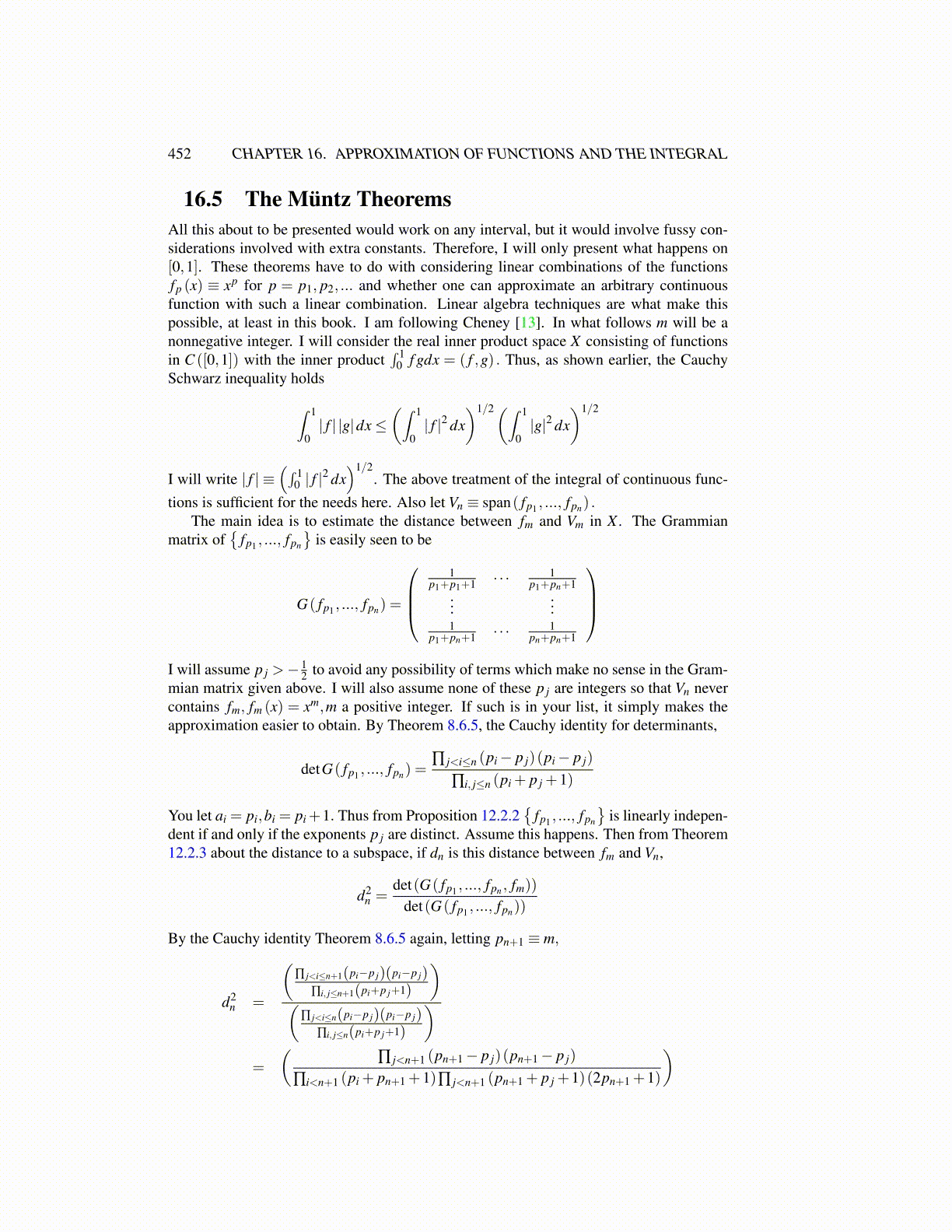
452 CHAPTER 16. APPROXIMATION OF FUNCTIONS AND THE INTEGRAL
16.5 The Müntz TheoremsAll this about to be presented would work on any interval, but it would involve fussy con-siderations involved with extra constants. Therefore, I will only present what happens on[0,1]. These theorems have to do with considering linear combinations of the functionsfp (x) ≡ xp for p = p1, p2, ... and whether one can approximate an arbitrary continuousfunction with such a linear combination. Linear algebra techniques are what make thispossible, at least in this book. I am following Cheney [13]. In what follows m will be anonnegative integer. I will consider the real inner product space X consisting of functionsin C ([0,1]) with the inner product
∫ 10 f gdx = ( f ,g) . Thus, as shown earlier, the Cauchy
Schwarz inequality holds
∫ 1
0| f | |g|dx≤
(∫ 1
0| f |2 dx
)1/2(∫ 1
0|g|2 dx
)1/2
I will write | f | ≡(∫ 1
0 | f |2 dx)1/2
. The above treatment of the integral of continuous func-tions is sufficient for the needs here. Also let Vn ≡ span( fp1 , ..., fpn) .
The main idea is to estimate the distance between fm and Vm in X . The Grammianmatrix of
{fp1 , ..., fpn
}is easily seen to be
G( fp1 , ..., fpn) =
1
p1+p1+1 · · · 1p1+pn+1
......
1p1+pn+1 · · · 1
pn+pn+1
I will assume p j >− 1
2 to avoid any possibility of terms which make no sense in the Gram-mian matrix given above. I will also assume none of these p j are integers so that Vn nevercontains fm, fm (x) = xm,m a positive integer. If such is in your list, it simply makes theapproximation easier to obtain. By Theorem 8.6.5, the Cauchy identity for determinants,
detG( fp1 , ..., fpn) =∏ j<i≤n (pi− p j)(pi− p j)
∏i, j≤n (pi + p j +1)
You let ai = pi,bi = pi+1. Thus from Proposition 12.2.2{
fp1 , ..., fpn
}is linearly indepen-
dent if and only if the exponents p j are distinct. Assume this happens. Then from Theorem12.2.3 about the distance to a subspace, if dn is this distance between fm and Vn,
d2n =
det(G( fp1 , ..., fpn , fm))
det(G( fp1 , ..., fpn))
By the Cauchy identity Theorem 8.6.5 again, letting pn+1 ≡ m,
d2n =
(∏ j<i≤n+1(pi−p j)(pi−p j)
∏i, j≤n+1(pi+p j+1)
)(
∏ j<i≤n(pi−p j)(pi−p j)∏i, j≤n(pi+p j+1)
)=
(∏ j<n+1 (pn+1− p j)(pn+1− p j)
∏i<n+1 (pi + pn+1 +1)∏ j<n+1 (pn+1 + p j +1)(2pn+1 +1)
)